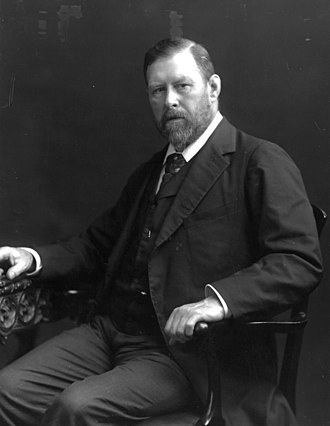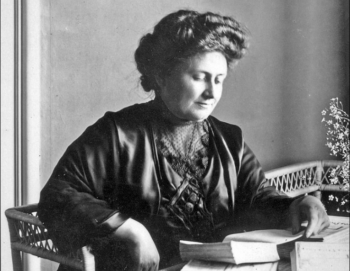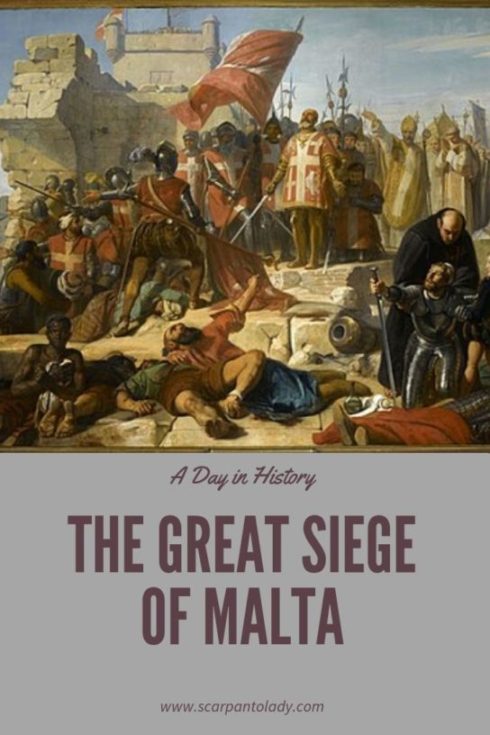
Early Years
Abraham “Bram”Stoker was born on 8 November 1847 at 15 Marino Crescent, Clontarf, on the northside of Dublin, Ireland. His parents were Abraham Stoker from Dublin and Charlotte Mathilda Blake Thornley, who was raised in County Sligo.
Stoker was the third of seven children, the eldest of whom was Sir Thornley Stoker. Abraham and Charlotte were members of the Church of Ireland Parish of Clontarf and attended the parish church with their children, who were baptised there.
Stoker was bedridden with an unknown illness until he started school at the age of seven, when he made a complete recovery. Of this time Stoker wrote: “I was naturally thoughtful, and the leisure of long illness gave opportunity for many thoughts which were fruitful according to their kind in later years.” He was educated in a private school run by the Rev. William Woods.
After his recovery he grew up without further serious illnesses even excelling as an athlete at Trinity College, Dublin, which he attended from 1864 to 1870.
He graduated with a BA in 1870 and pursued his MA in 1875. He was auditor of the College Historical Society (the Hist) and president of the University Philosophical Society, where his first paper was on Sensationalism in Fiction and Society.
Early Career
Stoker became interested in the theatre while a student through his friend Dr. Maunsell. While working for the Irish Civil Service he became the theatre critic for the Dublin Evening Mail, which was co-owned by Sheridan Le Fanu.
Theatre critics were generally held in low esteem but he attracted notice by the quality of his reviews. In December 1876 he gave a favourable review of Henry Irving’s Hamlet at the Theatre Royal in Dublin.
Irving invited Stoker for dinner at the Shelbourne Hotel where he was staying and they became friends. Stoker also wrote stories, with “The Crystal Cup” being published by the London Society in 1872, followed by “The Chain of Destiny” in four parts in The Shamrock.
In 1876, while working as a civil servant in Dublin, Stoker wrote the non-fiction book The Duties of Clerks of Petty Sessions in Ireland (published in 1879) which remained a standard work.
Work at Lyceum Theatre
In 1878 Stoker married Florence Balcombe, daughter of Lieutenant-Colonel James Balcombe of 1 Marino Crescent. She was a celebrated beauty whose former suitor had been Oscar Wilde.
Stoker had known Wilde from his student days, having proposed him for membership of the university’s Philosophical Society while he was president. Wilde was upset at Florence’s decision but Stoker later resumed the acquaintanceship and, after Wilde’s fall, visited him on the Continent.

The Stokers moved to London where Stoker became acting manager and then business manager of Irving’s Lyceum Theatre, London, a post he held for 27 years.
On 31 December 1879, Bram and Florence’s only child was born, a son whom they christened Irving Noel Thornley Stoker.
The collaboration with Henry Irving was important for Stoker and through him he became involved in London’s high society, where he met James Abbott McNeill Whistler and Sir Arthur Conan Doyle (to whom he was distantly related).
Working for Irving, the most famous actor of his time, and managing one of the most successful theatres in London made Stoker a notable if busy man. He was dedicated to Irving and his memoirs show he idolised him.
In London, Stoker also met Hall Caine who became one of his closest friends and to whom he dedicated Dracula.
In the course of Irving’s tours Stoker travelled the world, although he never visited Eastern Europe, the setting for his most famous novel. With Irving he was invited twice to the White House and met William McKinley and Theodore Roosevelt.
Stoker enjoyed the United States so much that he set two of his novels in America and used Americans as characters, the most notable being Quincey Morris.
Cruden Bay
Stoker was a regular visitor to Cruden Bay in Scotland between 1893 and 1910. His month-long holidays to the Aberdeenshire coastal village provided a large portion of available time for writing his books.
Two novels were set in Cruden Bay: The Watter’s Mou‘ (1895) and The Mystery of the Sea (1902). He started writing Dracula here in 1895 while in residence at the Kilmarnock Arms Hotel.
The nearby Slains Castle (also known as New Slains Castle) is linked with Stoker and plausibly provided the visual palette for the descriptions of Castle Dracula during the writing phase (a notable example being the octagonal hall in Slains Castle which matches the description of the octagonal room in Castle Dracula).
Writing
Stoker visited the English coastal town of Whitby in 1890 and that visit was said to be part of the inspiration for Dracula. He began writing novels while working as manager for Irving and secretary and director of London’s Lyceum Theatre, beginning with The Snake’s Pass in 1890 and Dracula in 1897.
During this period Stoker was part of the literary staff of The Daily Telegraph in London and he wrote other fiction, including the horror novels The Lady of the Shroud (1909) and The Lair of the White Worm (1911).
In 1906 he published his Personal Reminiscences of Henry Irving after Irving’s death, which proved successful, and he also managed productions at the Prince of Wales Theatre.
Before writing Dracula, Stoker met Ármin Vámbéry, a Hungarian-Jewish writer and traveller. Dracula likely emerged from Vámbéry’s dark stories of the Carpathian mountains. Stoker then spent several years researching Central and East European folklore and mythological stories of vampires.
The 1972 book In Search of Dracula by Radu Florescu and Raymond McNally claimed that the Count in Stoker’s novel was based on Vlad III Dracula, one of the most important rulers in Wallachian history and a national hero of Romania..
At most however, Stoker borrowed only the name and “scraps of miscellaneous information” about Romanian history, according to one expert, Elizabeth Miller.
Dracula is an epistolary novel, written as a collection of realistic but completely fictional diary entries, telegrams, letters, ship’s logs, and newspaper clippings, all of which added a level of detailed realism to the story, a skill which Stoker had developed as a newspaper writer.
At the time of its publication, Dracula was considered a “straightforward horror novel” based on imaginary creations of supernatural life.
Stoker was a deeply private man but his almost sexless marriage, intense adoration of Walt Whitman, Henry Irving and Hall Caine, and shared interests with Oscar Wilde, as well as the homoerotic aspects of Dracula have led to scholarly speculation that he was a repressed homosexual who used his fiction as an outlet for his sexual frustrations.
In 1912 he demanded imprisonment of all homosexual authors in Britain: it has been suggested that this was due to self-loathing and to disguise his own vulnerability.
Possibly fearful and inspired by the monstrous image and threat of otherness that the press coverage of his friend Oscar’s trials generated, Stoker began writing Dracula only weeks after Wilde’s conviction.
According to the Encyclopedia of World Biography, Stoker’s stories are today included in the categories of “horror fiction”, “romanticized Gothic” stories, and “melodrama.”
The original 541-page typescript of Dracula was believed to have been lost until it was found in a barn in northwestern Pennsylvania in the early 1980s. It consisted of typed sheets with many emendations and handwritten on the title page was “THE UN-DEAD.” The author’s name was shown at the bottom as Bram Stoker.
Stoker’s inspirations for the story in addition to Whitby and Slain Castle in Aberdeenshire, may have included a visit to the crypts of St. Michan’s Church in Dublin and the novella Carmilla by Sheridan Le Fanu.[23]
Stoker’s original research notes for the novel are kept by the Rosenbach Museum and Library in Philadelphia.
Beliefs and Philosophy of Life
Stoker was raised a Protestant in the Church of Ireland. He was a strong supporter of the Liberal Party and took a keen interest in Irish affairs. As a “philosophical home ruler,” he supported Home Rule for Ireland brought about by peaceful means.
He remained an ardent monarchist who believed that Ireland should remain within the British Empire, an entity that he saw as a force for good. He was an admirer of Prime Minister William Ewart Gladstone, whom he knew personally and supported his plans for Ireland.
He believed in progress and took a keen interest in science and science-based medicine. Some of Stoker’s novels represent early examples of science fiction, such as The Lady of the Shroud (1909).
He had a writer’s interest in the occult, notably mesmerism, but despised fraud and believed in the superiority of the scientific method over superstition.
Stoker counted among his friends J.W. Brodie-Innis, a member of the Hermetic Order of the Golden Dawn and hired member Pamela Colman Smith as an artist for the Lyceum Theatre, but no evidence suggests that Stoker ever joined the Order himself.
Although Irving was an active Freemason, no evidence has been found of Stoker taking part in Masonic activities in London. The Grand Lodge of Ireland also has no record of his membership.
Death
After suffering a number of strokes Stoker died at No. 26 St George’s Square, London on 20 April 1912.
Some biographers attribute the cause of death to tertiary syphilis, while others to overwork. He was cremated and his ashes were placed in a display urn at Golders Green Crematorium in north London.
The ashes of Irving Noel Stoker were added to his father’s urn following his death in 1961. The original plan had been to keep his parents’ ashes together, but after Florence Stoker’s death, her ashes were scattered at the Gardens of Rest.


